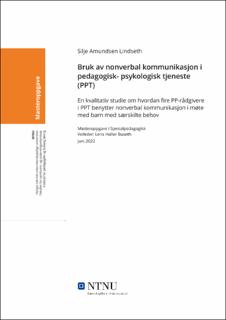| dc.contributor.advisor | Buseth, Lena Haller | |
| dc.contributor.author | Lindseth, Silje Amundsen | |
| dc.date.accessioned | 2022-10-07T17:34:12Z | |
| dc.date.available | 2022-10-07T17:34:12Z | |
| dc.date.issued | 2022 | |
| dc.identifier | no.ntnu:inspera:110002054:23052347 | |
| dc.identifier.uri | https://hdl.handle.net/11250/3024794 | |
| dc.description.abstract | Tema for denne studien er bruk av nonverbal kommunikasjon, og tar for seg hvordan PP-rådgivere i pedagogisk psykologisk tjenesten (PPT) tar i bruk denne type kommunikasjon i møte med barn med særskilte behov. Følgende problemstilling har vært utgangspunkt for studien:
«Hvordan benytter fire PP-rådgivere nonverbal kommunikasjon i møte med barn med særskilte behov?»
Målet med studien er å få en større innsikt i hvordan PP-rådgivere aktivt tar i bruk nonverbal kommunikasjon i møte med barn i yrkessammenheng. Her er det ønskelig å se på hvilken type kommunikasjon dette kan være, hvordan den brukes og hvilken effekt den kan ha for relasjonsbygging, læring og tilrettelegging. For å besvare den aktuelle problemstillingen ble det gjennomført kvalitativt intervju med fire PP-rådgivere fra to forskjellige kommuner fordelt på by og bygd. Videre ble funnene analysert og drøftet i lys av aktuell teori og tidligere forskning knyttet til området.
Hovedfunnene i studien viser at PP-rådgiverne både tar i bruk nonverbale hjelpemidler i arbeidssammenheng, men at de også bruker seg selv som redskap i møte med barna. Samtlige av PP-rådgiverne understreker at nonverbal kommunikasjon er en viktig og sentral faktor i kommunikasjon med barn, og dermed et viktig aspekt ved yrkespraksisen. Sentrale begreper som ble tatt opp i denne sammenheng er kongruens, det felles tredje, relasjonsbygging, toleransevinduet og barnets pausebehov. Avslutningsvis viser funnene at nonverbal kommunikasjon ikke er et tema som står like sentralt i faglig sammenheng, der det verken er en del av aktuelle handlingsplaner eller kompetansebygging i PP-tjenesten. Dette på tross av at tematikken fremstår som svært aktuell i yrkespraksis. | |
| dc.description.abstract | The topic of this study is “the use of nonverbal communication” and addresses how PP- advisors in the pedagogic/educational- psychologic service (PPT) utilize this type of communication when working with children who have special needs. The following research question has been the starting point of the study:
“How does four PP-counselors utilize nonverbal communication when working with children with special needs?”.
The goal of the study is to gain a better insight into how PP counselors actively use nonverbal communication in meetings with children in a professional context. It is desirable to look at what type of communication this can be, how it is used and what effect it can have for relationship building, learning and facilitation. To answer the current problem, a qualitative interview was conducted with four PP-advisors from two different municipalities, divided into urban and rural areas. Furthermore, the findings were analyzed and discussed in the light of current theory and previous research related to the topic.
The main findings of the study show that PP- counselors both use nonverbal aids in work contexts, but that they also use themselves as tools in meetings with the children. All the PP-advisors interviewed emphasized that nonverbal communication is an important and central factor when communicating with children, and thus an important aspect of the professional practice. Key concepts that were addressed in this context are congruence, the common third, relations, the tolerance window, and the child`s need for a break. In conclusion, the findings show that nonverbal communication is not a topic that is centralized in a professional context, where it is neither part of the current action plans nor competence building in the PP service. Despite the fact that the topic appears to be very relevant in professional practice, it does not receive the attention it deserves. | |
| dc.language | nob | |
| dc.publisher | NTNU | |
| dc.title | Bruk av nonverbal kommunikasjon i pedagogisk- psykologisk tjeneste (PPT) | |
| dc.type | Master thesis | |
